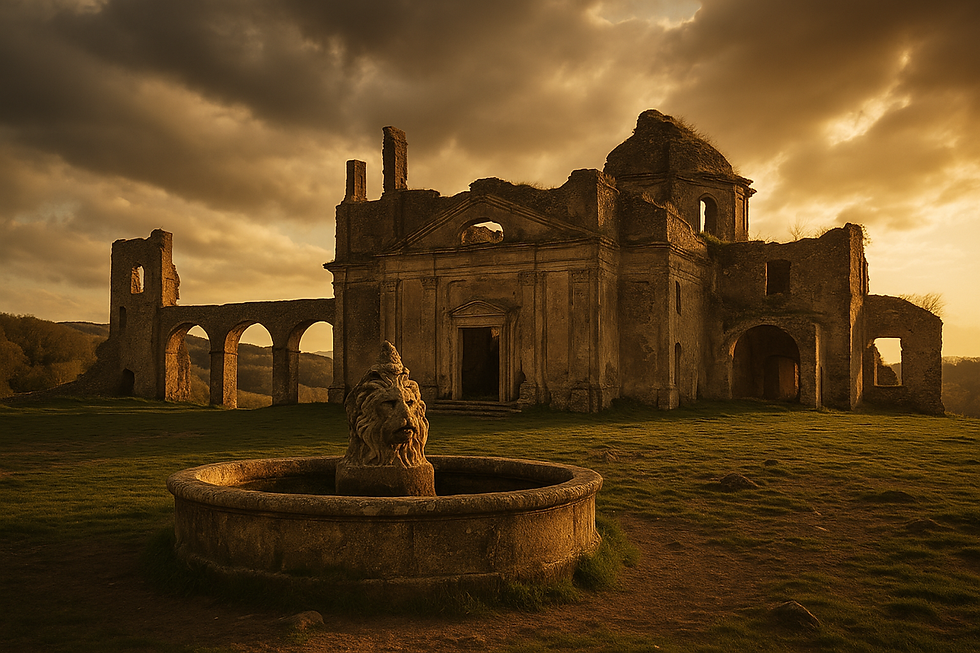Monterano: the Pompeii of Lazio, between history, ruins, and celluloid dreams
- Giano di Vico

- Jul 20
- 3 min read

Just a step from Rome and a breath away from the Etruscan hills, hidden within the silent folds of the Monterano Nature Reserve, lies a lost city that still speaks — Monterano, or more precisely, the Castle of Canale Monterano, suspended between ruin and rebirth, Baroque and sulfur, historic ghosts and modern film cameras.
📜 A Millennia-Old Story Carved in Stone and Faith
The first signs of life date back to the Bronze Age (11th century BC), but it was under Etruscan rule, from the 7th to the 4th century BC, that Monterano became a strategic center of the Caere lucumony. Known to the Romans as Manturianum, it quickly rose in religious importance, becoming an episcopal seat in 313 AD, succeeding Forum Clodii.
In the Middle Ages, Monterano was scarred by violent power struggles: in 730 AD, the ambitious Tiberius Petasiusattempted a coup against the Empire. Later, under the Anguillara and then the Orsini families, it went through periods of fortune and decline until a slow depopulation began in the 15th century.
👑 The Baroque Dream of the Altieri
The great revival came in 1671, when Pope Clement X, born Emilio Altieri, acquired the estate. It was a strategic move: the Pope entrusted Monterano to the Paluzzi Albertoni, who adopted the Altieri name to preserve its glory.
The dream was brought to life by none other than Gian Lorenzo Bernini, the genius of Baroque Rome, who transformed Monterano into a vision.
The Church and Convent of San Bonaventura, with its simple nave and now-lost bell towers, still hosts the legendary fig tree growing inside — made famous in Il Marchese del Grillo.
The Ducal Palace – the so-called Orsini-Altieri Castle – was redesigned with a six-arch loggia connecting a medieval tower and a Renaissance one.
The Lion Fountain, sculpted into stone, symbolized power flowing generously like living water.
The 17th-century aqueduct, nine meters tall, winds monumentally through the landscape — a spine of stone, history, and legend.
⚔️ 1799: The Fiery End
In March 1799, it all came to an end. French troops occupying the newborn Roman Republic burned Monterano after a dispute over a grain shipment with Tolfa. It was a brutal reprisal that erased a community already ravaged by malaria, famine, and war. The people finally relocated to Canale Monterano. Since then, the stones speak only with the wind.
🎬 Hollywood Among the Ruins
Monterano found its revenge — not as a living city, but as an immortal one on screen.
From the Oscar-sweeping Ben-Hur (1959), to Pasolini’s sacred neorealism in The Gospel According to Matthew (1964), and the immortal masks of Totò and Gassman, Monterano has been both setting and protagonist.
The fig tree in the church became iconic in Il Marchese del Grillo, where Flavio Bucci played Fra’ Bastiano in one of the most powerful scenes in Italian cinema.
And then: Ladyhawke, The Black Arrow, Le tre rose di Eva, The Witches’ Sabbath… A star resume without makeup.
🌿 Nature Reclaims
Since 1988, Monterano is also a Regional Nature Reserve. With over 1,000 hectares of biodiversity, it’s a perfect mosaic of ruin and life — home to wildcats, martens, newts, wild orchids, and even rare prehistoric ferns.
The hills are laced with trails leading to sulfur springs, Etruscan cuts, and the mystical Diosilla Waterfall, which shifts color with sunlight and sulfur.
💎 What to See: Recommended Itinerary
The Monumental Aqueduct – a spectacular entrance under grand 17th-century arches.
Church and Convent of San Bonaventura – with the octagonal fountain and cinematic fig tree.
Orsini-Altieri Castle – offering breathtaking views over the Mignone Valley.
Other sites: Porta Gradella, Cathedral Bell Tower, Church of San Rocco.
Nature trails – from Diosilla Falls to the Sulfur Fields, over wooden bridges and whispering earth.
🗺️ Practical Info
From Viterbo: 45 minutes, take the Oriolo Romano exit on the SS675.
Recommended parking: Comunaletto (200m walk).
Entry: free, open 24 hours.
Accessibility: easy, ideal for families.
Services: picnic areas, guided tours, visitor center in Canale Monterano.
🔍 Curiosities for Every Taste
Devil’s Aqueduct: built in a single night? No, but definitely without mortar!
Orsini wine: a legendary harvest reserved only for cardinals and princes.
The fig actor: starred with Alberto Sordi, now fighting to survive.
Nature persists: between moss and ruins, life always wins.
Monterano isn’t just a place — it’s an experience.
A ghost town breathing art, a temple of nature embracing history,
a page torn from time that rewrites itself under the feet of the curious traveler.
Come once, and you’ll return — in dreams.




Comments